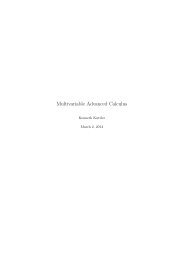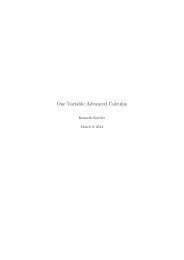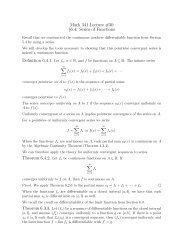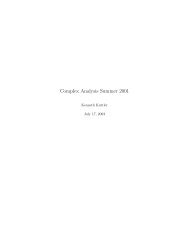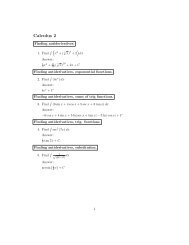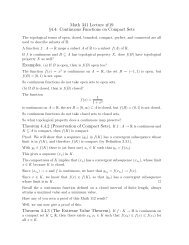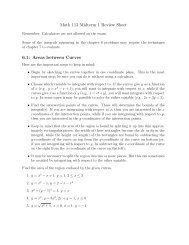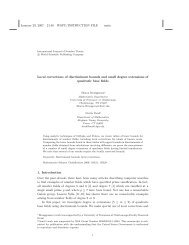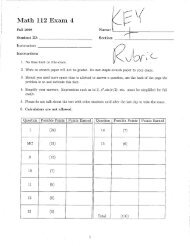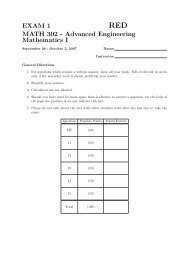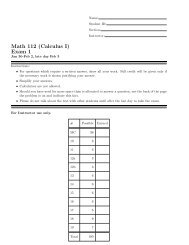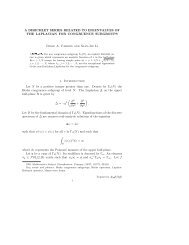Math 341 Lecture #21 §4.1,4.6: Sets of Discontinuities, Part I
Math 341 Lecture #21 §4.1,4.6: Sets of Discontinuities, Part I
Math 341 Lecture #21 §4.1,4.6: Sets of Discontinuities, Part I
Create successful ePaper yourself
Turn your PDF publications into a flip-book with our unique Google optimized e-Paper software.
<strong>Math</strong> <strong>341</strong> <strong>Lecture</strong> <strong>#21</strong>§4.1,<strong>4.6</strong>: <strong>Sets</strong> <strong>of</strong> <strong>Discontinuities</strong>, <strong>Part</strong> IWe begin with several examples that illustrate how discontinuous functions can be.For a function f : R → R, we let D fcontinuous.Example. Dirichlet defined a function g : R → R by{1 if x ∈ Q,g(x) =0 if x ∉ Q.denote the set <strong>of</strong> points in R where f is notFor any c ∈ R we can find sequences (x n ) in Q and (y n ) in R \ Q such that x n → c andy n → c, but for which g(x n ) = 1 and g(y n ) = 0 for all n ∈ N, so thatlim g(x n) ≠ lim g(y n ).n→∞ n→∞By the Criterion for Discontinuity, the function g is not continuous anywhere; it isnowhere continuous function.We have that D g = R.Example. A modification <strong>of</strong> Dirichlet’s function results in a function that is continuousat just one point.Define h : R → R byh(x) ={x if x ∈ Q,0 if x ∉ Q.For a nonzero c we can find sequences (x n ) in Q and (y n ) in R \ Q such that x n → c andy n → c, but for which h(x n ) = x n and h(y n ) = 0 for all n ∈ N, so thatlim h(x n) = c ≠ 0 = lim h(y n ).n→∞ n→∞By the Criterion for Discontinuity, the function h is not continuous at every point c ≠ 0.However, if c = 0, then for any sequence (z n ) in R with z n → 0 we have |h(z n )| ≤ |z n |,so that h(z n ) → 0 as well.Thus h is continuous at c = 0.We have that D h = R \ {0}.Example. Thomae defined a function t : R → R by⎧⎪⎨ 1 if x = 0,t(x) = 1/n if x = m/n ∈ Q \ {0} in lowest terms with n > 0,⎪⎩0 if x ∉ Q.For c ∈ Q, we have t(c) > 0.
For a sequence (y n ) in R \ Q such that y n → c, we have t(y n ) = 0 for all n ∈ N, so thatt(c) ≠ 0 = limn→∞t(y n ).This says that t is discontinuous at every rational point.On the other hand, if c is irrational, we have t(c) = 0.For any sequence (x n ) in R such that x n → c we have t(x n ) = 0 when x n ∉ Q or t(x n ) isthe reciprocal <strong>of</strong> the positive denominator <strong>of</strong> the rational x n is lowest terms.The closer x n is to the irrational c, the larger the denominator <strong>of</strong> x n is, so that t(x n ) isas close to 0 as needed.The result <strong>of</strong> this is that t(x n ) → 0 as n → ∞, that is, we haveand so t is continuous at every irrational c.We have that D t = Q.Example. Define a function s : R → R bylim t(x n) = 0 = t(c),n→∞s(x) = [[x]]where [[x]] is the largest integer n such that n ≤ s.For c ∈ R such that n < c < n + 1 for n ∈ N, we have for any sequence (x n ) convergingto c thatlimn→∞ s(x n) = n = [[c]].On the other hand, for c = n for n ∈ N, we take a sequence (y n ) such that n−1 < y n < nand y n → c, so thatlimn→∞ s(y n) = n − 1 ≠ [[c]] = n.Thus s is discontinuous at every integer point, and we have that D s = Z.Example. Define a function f : R → R by⎧0 if x ≤ 0,⎪⎨x if x ∈ Q ∩ (0, 1),f(x) =0 if x ∈ (0, 1) \ Q,⎪⎩0 if x ≥ 1.The function is continuous at every c < 0 and at every c > 1.As with the modified Dirichlet function, this function f is continuous at c = 0, butdiscontinuous at every c ∈ (0, 1).This function is also discontinuous at c = 1 because for a rational sequence (x n ) in (0, 1)with x n → 1 we have f(x n ) = x n → 1, while for any sequence (y n ) with y n > 1 andy n → 1 we have f(y n ) → 0.So here we have D f = (0, 1].
It is a homework problem (Exercise 4.<strong>4.6</strong>) for you to show that in each <strong>of</strong> these examples,the set <strong>of</strong> points <strong>of</strong> discontinuity is an F σ set.At this point you might be wondering what kinds <strong>of</strong> subsets <strong>of</strong> R can be sets <strong>of</strong> discontinuityfor functions f : R → R.If you are thinking an F σ set, you are correct.To prove this is somewhat involved, so first we focus on a simpler class <strong>of</strong> functions f forwhich D f is more readily understood.Definition. <strong>4.6</strong>.1. A function f : A → R is increasing on A if f(x) ≤ f(y) wheneverx < y for x, y ∈ A, and is decreasing if f(x) ≥ f(y) whenever x < y for x, y ∈ A.A function f : A → R is monotone if f is either increasing or decreasing.The function s(x) = [[x]] on R is monotone increasing.In showing that s(x) is discontinuous at every integer point, we took a sequence y n suchthat n − 1 < y n < n and y n → n.This is a sequence that approaches n from the left.We can talk about functional limits in the same way: from the left or from the right.Definition. <strong>4.6</strong>.2. Given a limit point c <strong>of</strong> a nonempty set A and a function f : A → Rwe writelimx→c + f(x) = Lif for all ɛ > 0 there exists δ > 0 such that |f(x) − L| < ɛ whenever 0 < x − c < δ andx ∈ A.In terms <strong>of</strong> sequences this is the same as (x n ) in A with x n > c and x n → c, for whichf(x n ) → L.We writelim f(x) = Lx→c −if for all ɛ > 0 there exists δ > 0 such that |f(x) − L| < ɛ whenever 0 < c − x < δ andx ∈ A.In terms <strong>of</strong> sequence this is the same as (x n ) in A with x n < c and x n → c, for whichf(x n ) → L.Theorem <strong>4.6</strong>.3. Let f : A → R and c a limit point <strong>of</strong> A. Then lim x→c f(x) = L if andonly iflim f(x) = L and limx→c− f(x) = L.x→c +It is a homework problem (Exercise <strong>4.6</strong>.3) to supply a pro<strong>of</strong> <strong>of</strong> this.



